 |
 |
| Preserving the
ideals of Prince Shotoku and the treasure house of ancient
culture |
|
 |
 |
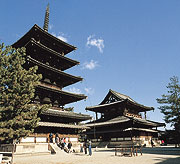 Established
in 607 A.D. by Prince Shotoku, a vigorous supporter of Buddhism,
Horyuji Temple was inscribed on the world heritage list in
1993 as the oldest wooden structure in the world. Various
national treasures representing Japanese Buddhist art are
displayed, such as the statue of 'Kudara Kannon' in the Kudara-Kannon-Do
Hall of the DaihoZoin treasure house. The precinct is divided
into the West Precinct and the East Precinct. In the former
are structures of the Asuka Period or 8th century, such as
the five-storied pagoda and the Kondo Hall. "Tamamushi-no-Zushi,"
a Buddhist alter of the Asuka Period, Yumechigai Kannon statue,
and other temple treasures are also found in this Precinct.
The Tamamushi-no-Zushi, is decorated with the wings of jewel
beetles laid under the metal openwork. In the East Precinct
is the Yumedono, the eldest octagonal hall in Japan. "Guze
Kannon" a life-sized wooden Buddhist statue of Prince Shotoku
is kept here. Established
in 607 A.D. by Prince Shotoku, a vigorous supporter of Buddhism,
Horyuji Temple was inscribed on the world heritage list in
1993 as the oldest wooden structure in the world. Various
national treasures representing Japanese Buddhist art are
displayed, such as the statue of 'Kudara Kannon' in the Kudara-Kannon-Do
Hall of the DaihoZoin treasure house. The precinct is divided
into the West Precinct and the East Precinct. In the former
are structures of the Asuka Period or 8th century, such as
the five-storied pagoda and the Kondo Hall. "Tamamushi-no-Zushi,"
a Buddhist alter of the Asuka Period, Yumechigai Kannon statue,
and other temple treasures are also found in this Precinct.
The Tamamushi-no-Zushi, is decorated with the wings of jewel
beetles laid under the metal openwork. In the East Precinct
is the Yumedono, the eldest octagonal hall in Japan. "Guze
Kannon" a life-sized wooden Buddhist statue of Prince Shotoku
is kept here. 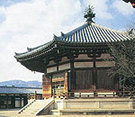 The
statue is open to the public from mid-April to mid-May and
from mid-October to mid-November. The
statue is open to the public from mid-April to mid-May and
from mid-October to mid-November.
 0745-75-2555
/ 8:00 - 17:00 (Varies depending upon seasons, but from Feb.
22 to Nov. 3, 8:00- 15:55) / Open 7 days a week 0745-75-2555
/ 8:00 - 17:00 (Varies depending upon seasons, but from Feb.
22 to Nov. 3, 8:00- 15:55) / Open 7 days a week
  1,000 1,000
 Take
bus No. 52, 97 or 98 from JR Horyuji Station and get off at
Horyuji Mon Mae. Take
bus No. 52, 97 or 98 from JR Horyuji Station and get off at
Horyuji Mon Mae. |
 |
 |
| Smiling Status
of Mirokubosatsu |
|
 |
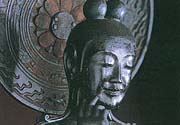 Exclusively
for nuns, this temple is said to be rebuilt from the former
home of the mother of Prince Shotoku, who designed Japan's
first constitution, comprising of 17 articles. A sitting statue
of the Mirokubosatsu, or divine savior whose mission is to
relieve people's suffering, has been designated as a national
treasure. It is made of Japanese cinnamon wood and dates from
the 6th century. With its right leg resting on the left knee
and the right hand raised to the cheek, Mirokubosatsu has
a noble figure and gives a delicate but beautiful smile. Exclusively
for nuns, this temple is said to be rebuilt from the former
home of the mother of Prince Shotoku, who designed Japan's
first constitution, comprising of 17 articles. A sitting statue
of the Mirokubosatsu, or divine savior whose mission is to
relieve people's suffering, has been designated as a national
treasure. It is made of Japanese cinnamon wood and dates from
the 6th century. With its right leg resting on the left knee
and the right hand raised to the cheek, Mirokubosatsu has
a noble figure and gives a delicate but beautiful smile.
 0745-75-2106/9:00-16:30(Varies
depending upon halls) /Open 7 days a week 0745-75-2106/9:00-16:30(Varies
depending upon halls) /Open 7 days a week
  500 500
 Take
bus No. 60, 63 or 92 from JR Oji Station and get off at Chuguji
Mae. A 5-minute walk from the bus stop Take
bus No. 60, 63 or 92 from JR Oji Station and get off at Chuguji
Mae. A 5-minute walk from the bus stop |
 |
| The oldest three-storied
pagoda in Japan. |
|
 |
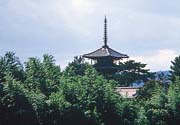 The
three-storied pagoda, approx. 24m in height is the oldest,
and also the largest of its kind in Japan and has been registered
as world heritage. It was established in 706 A.D. The statue
known as "Juichimen Kannon" or Boddhisattva (divine Buddhist
savior) with eleven faces (ten on top of its main face), has
been designated as an important cultural asset. The
three-storied pagoda, approx. 24m in height is the oldest,
and also the largest of its kind in Japan and has been registered
as world heritage. It was established in 706 A.D. The statue
known as "Juichimen Kannon" or Boddhisattva (divine Buddhist
savior) with eleven faces (ten on top of its main face), has
been designated as an important cultural asset.
 0745-75-5559/8:30-16:30,(April
to October: 8:30 - 17:00)/Open 7 days a week 0745-75-5559/8:30-16:30,(April
to October: 8:30 - 17:00)/Open 7 days a week
  300 300
 Take bus No. 60 or 63 from JR Oji Station and get off at Hokijiguchi.
A 10-minute walk from the bus stop / Take bus No. 50 or 97
from Kintetsu Koriyama Station and get off at Hokiji Mae.
Take bus No. 60 or 63 from JR Oji Station and get off at Hokijiguchi.
A 10-minute walk from the bus stop / Take bus No. 50 or 97
from Kintetsu Koriyama Station and get off at Hokiji Mae. |
 |
| Praying for recovery
of his father's illness |
|
 |
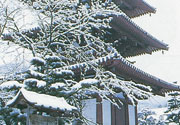 Prince
Shotoku's achievements include the establishment of Japan's
first "Kan Junikai" system, a merit based promotion system
irrespective of social class. It is said that this temple
was built by his son Prince Yamashiro no-o-e, who prayed for
Prince Shotoku's recovery from illness. "Yakushinyorai," "Kokubosatsu"
and other fine Buddhist statues, divine saviors of the present
suffering of mankind, are located there. Prince
Shotoku's achievements include the establishment of Japan's
first "Kan Junikai" system, a merit based promotion system
irrespective of social class. It is said that this temple
was built by his son Prince Yamashiro no-o-e, who prayed for
Prince Shotoku's recovery from illness. "Yakushinyorai," "Kokubosatsu"
and other fine Buddhist statues, divine saviors of the present
suffering of mankind, are located there.
 0745-75-2686/Kodo
Hall 8:00-17:00(or 16:30 in winter)/Open 7 days a week 0745-75-2686/Kodo
Hall 8:00-17:00(or 16:30 in winter)/Open 7 days a week
  400 400
 Take
bus No. 60, 63 or 92 from JR Oji Station and get off at Chuguji
Mae. A 15-minute walk from the bus stop Take
bus No. 60, 63 or 92 from JR Oji Station and get off at Chuguji
Mae. A 15-minute walk from the bus stop |
 |
 |
 |

Chogosonshiji Temple on Mt. Shigi |
 |
| Home to the world's
largest papier-tiger. |
|
 |
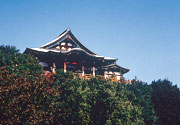 Located
halfway up Mt. Shigi (437m above sea-level), this temple is
popular for its "Bishamonten" statue, a deity of money, virtue
and luck. Many worshippers visit the temple every day, irrespective
of whether a special ritual is held or not. Smaller versions
of the world's largest papier-tiger are a very popular souvenir
of Mt. Shigi. Located
halfway up Mt. Shigi (437m above sea-level), this temple is
popular for its "Bishamonten" statue, a deity of money, virtue
and luck. Many worshippers visit the temple every day, irrespective
of whether a special ritual is held or not. Smaller versions
of the world's largest papier-tiger are a very popular souvenir
of Mt. Shigi.
 0745-72-2277
/ Reihokan Treasure Hall : 9:00 - 16:30 / Open 7 days a week 0745-72-2277
/ Reihokan Treasure Hall : 9:00 - 16:30 / Open 7 days a week
  200
( 200
( 300
for the two weeks starting from the last Sunday in October) 300
for the two weeks starting from the last Sunday in October)
 Take
bus No.16 or 32 from Kintetsu Shigisanshita Station and get
off at Shigisan. A 15-minute walk from the bus stop Take
bus No.16 or 32 from Kintetsu Shigisanshita Station and get
off at Shigisan. A 15-minute walk from the bus stop |
|

